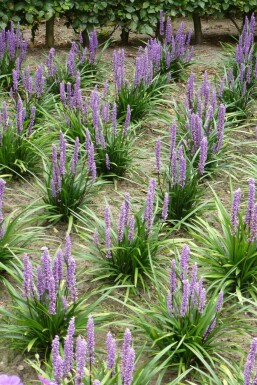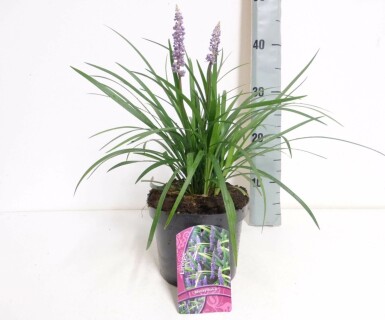




Updated on 10 September 2025
We regret to inform you that we are currently unable to ship orders to the United Kingdom. We anticipate being able to resume shipments at the beginning of 2026.
Liriope is perfect for shady gardens, offering strong ground cover and beautiful purple flower spikes in late summer. It's evergreen, making it an ideal choice for year-round interest. Suitable for borders, pots, and under shrubs, liriope enhances any garden space.
Liriope is a wonderful addition to any garden, known for its grass-like foliage and late summer blooms. This evergreen plant showcases upright purple or lilac flowers that truly stand out. It thrives in shady and semi-shady areas, providing a perfect ground cover solution. Curious how Liriope can transform your garden into an evergreen paradise? With its narrow, glossy leaves and black berries, Liriope offers both beauty and functionality. Suitable for dry shady spots, this perennial is perfect for under shrubs or as an edging plant. If considering a new plant for your garden, Liriope, also known as lilyturf and monkey grass, might be the ideal choice. Explore options to buy Liriope in the UK for your next gardening project.
Liriope, also known as lilyturf, is a versatile plant often used in gardens for its grass-like foliage and resilience. It is also called monkey grass, Liriope groundcover, or grass-like perennial. Liriope is used as an evergreen groundcover, ideal for shady areas, borders, and planters. Belonging to the Asparagaceae family, it originates from East Asia, including China, Japan, and Korea. Liriope thrives worldwide and is perfect for shaded gardens. Its ecological role includes serving as ground cover in shady borders, benefiting from its flower spikes that attract bees in late summer. The name Liriope derives from Greek mythology, symbolising underground beauty and feminine energy, making it appealing in natural garden settings. Liriope grows slowly and is an evergreen ground cover that tolerates shade, heat, and drought. If seeking an evergreen groundcover for dry, shady areas, lilyturf is a good choice. For gardeners in the UK wanting to buy Liriope, this plant offers an excellent solution for low-maintenance, attractive landscapes.
Liriope, commonly known as lilyturf, is a versatile and resilient plant that serves as a perfect ground cover. It features grass-like foliage and is often found in shaded gardens. This evergreen ground cover slowly grows, forming dense clumps that can withstand shade, heat, and drought. Its leaves are narrow and glossy, providing a lush green backdrop throughout the year. The growth of Liriope begins early in the season, with the plant steadily developing its distinctive foliage. By the time August and September arrive, Liriope displays its stunning flower spikes in shades of purple, violet, and occasionally white. The timing of its blooms depends on factors like climate, temperature, and the age of the plant. Proper soil preparation and consistent care also play significant roles in its flowering success. Liriope's blooms are not only visually appealing but also add a subtle fragrance to the garden. This scent is influenced by the plant's foliage, stems, and the intensity of its fragrance varies with environmental conditions. As a ground-covering garden plant with purple flower spikes, it brings vibrant colour to any landscape. Liriope generally reaches a height of 20 cm to 60 cm, depending on the variety and growing conditions such as soil type and care. Its adaptability to various environments makes it an excellent choice for borders, pots, and natural gardens. The addition of lilyturf to any garden enhances biodiversity and offers a robust, low-maintenance solution for gardeners.
Liriope features grass-like, elongated leaves that arch gracefully. The leaves are mostly dark green but can sometimes appear variegated with purple-green hues. This evergreen foliage is well-suited to various environmental factors, offering resistance to shade, drought, and air pollution. Being moderately hardy, Liriope can withstand temperatures as low as -18°C, making it suitable for USDA zones 6 to 8. The winter period may not affect it much, thanks to its grassy evergreen nature, allowing it to maintain its foliage throughout the colder months. It's best for underplanting and can thrive in dry shade areas in the UK.
In terms of heat and drought tolerance, Liriope's structure aids in retaining moisture. Its deep root system and washy layer on the leaves help minimise water loss, making it resilient during warmer months. It's essential to consider soil moisture and wind exposure for optimal growth. Fortunately, Liriope is not toxic, ensuring a safe environment for children and pets. Its use as a ground cover adds both beauty and functionality to gardens.
Regarding biodiversity, Liriope offers ecological benefits. Its purple flower spikes, blooming from August to October, attract pollinators and support garden ecosystems. By mimicking natural habitats, Liriope increases the resistance of gardens to diseases and pests, providing food and shelter for various creatures. Its decorative and ecological value makes it a versatile choice for enhancing garden spaces.
Liriope is a versatile plant that adds beauty and functionality to any garden. Known for its vibrant spikes of purple flowers, it thrives in shady and semi-shady gardens. Here are some fantastic ways to incorporate liriope into your outdoor space:
Liriope is a versatile plant that fits well in shady and semi-shady gardens. It pairs beautifully with ferns, adding texture and depth to the garden. Hostas bring a variety of leaf colours that complement Liriope's grass-like appearance. Consider adding Heuchera for vibrant foliage in different shades. Brunnera provides lovely blue flowers that pop against Liriope's blooms, while Athyrium offers delicate fronds for a soft touch. Another excellent companion is Lamium, which adds silver leaves to brighten darker areas. These combinations work seamlessly because they thrive in similar conditions and provide year-round interest. Liriope blooms late in the year and forms an attractive shrub for shady borders. This blend of plants not only covers the ground effectively but also creates a dynamic and inviting garden design. By mixing these plants, gardens achieve a balanced look with a mix of colours and textures that engage the eyes throughout all seasons.
Liriope, known as lilyturf, is a versatile plant that thrives in semi-shade to shade environments. It can tolerate drought, but performs best in moist, well-drained soil. Ideally, it should receive at least four hours of sunlight each day. Its ability to grow in partial shade makes it suitable for gardens with limited sun exposure. Liriope's resilience to wind is notable, though placing it near windbreaks can offer additional protection. This grass-like perennial prefers acidic to neutral, humus-rich soil, akin to forest floors. Regular fertilisation and ensuring a well-draining environment promote its growth. Soil moisture is crucial for Liriope. While it can withstand dry conditions, consistent moisture without waterlogging is ideal. Wind and sunlight influence soil dryness, so selecting the right location is key. For optimal growth, Liriope favours soil with an acidic to neutral pH. The pH level affects its nutrient uptake and overall health, making it important to monitor. By ensuring these conditions, this evergreen groundcover will thrive, adding beauty and resilience to garden spaces.
Plant Liriope during spring or autumn for best results, especially when the soil is moist. Liriope supplied in pots can be planted all year, except during frosty periods, whereas those with roots are better suited for spring and autumn planting. The spacing of Liriope depends on its type and growth rate. Smaller plants require denser planting, while larger ones need more room to spread. Check the Heijnen product page for plant-specific spacing details. Use humus-rich, well-draining soil, ideally in partial to full shade. It's important to prepare the ground by adding compost or leaf mould to enhance soil quality. Avoid dry, sandy soil. After planting Liriope, water regularly and ensure adequate nutrients by fertilising occasionally. Liriope thrives with at least four hours of sun per day and adapts well to shade, making it a versatile choice. Reliable as an evergreen groundcover, lilyturf adds a lush appearance to any garden setting. For an optimal Liriope (lilyturf) bloom, ensure the soil remains consistently moist and well-drained.
Liriope is a resilient plant, perfect for shaded areas and a good alternative to lawns. Providing the correct care ensures lush foliage and vibrant blooms from August to October. Here are essential tips for maintaining healthy Liriope.
Liriope stands out in any garden setting with its vibrant purple flower spikes and shiny, dark green leaves. These blooms, appearing in late summer, bring a pop of colour and are known to attract bees and butterflies, adding a lively touch to the garden. The foliage of lilyturf is grass-like and remains evergreen, creating a lush ground cover throughout the year. This plant works well as an underplanting beneath shrubs, where it can provide an appealing texture and serve as a hardy ground cover. In addition to its visual appeal, Liriope is a tough evergreen plant with purple spikes. Its ability to tolerate shade, heat, and drought makes it a versatile choice for various garden conditions, particularly in shaded areas. As an evergreen groundcover, Liriope maintains structure even in winter, offering visual interest during colder months. When planted in groups, monkey grass can effectively offer privacy and define garden spaces, making it a valuable addition to shady and semi-shady gardens. This long-blooming perennial ensures a beautiful display while being practical in maintaining garden aesthetics.
Liriope, also known as lilyturf, is a popular choice for UK gardeners looking for an evergreen groundcover that thrives in shady areas. With grass-like foliage and striking flower spikes, Liriope adds texture and interest to any garden. Here are some of the most popular Liriope varieties that are perfect for dry shade and late flowering.
These Liriope varieties offer varied choices for gardeners seeking to enhance their gardens with evergreen foliage and beautiful blooms. They are available for online purchase at Heijnen, making it easy to bring this versatile plant to any garden.
Liriope is a popular choice for gardeners looking for a reliable plant. It offers a range of benefits but also comes with specific challenges.
Advantages:
Disadvantages:
Proper soil preparation, choosing the right location, and regular care can help reduce the risk of pests and diseases. Ensuring plants are well-maintained promotes healthy growth and flowering.
Liriope is a perfect choice for adding beauty to shady and semi-shady gardens. When looking to buy Liriope UK, consider the benefits this plant brings to outdoor spaces. Known for its grass-like foliage, Liriope offers a practical solution for creating a strong groundcover. The evergreen foliage ensures a beautiful garden appearance throughout the year, even in the colder months. During August to October, expect lovely flower spikes that add an extra touch of elegance. Liriope is particularly effective as a groundcover for dry shady areas. Its root clumps provide stability and help reduce soil erosion. This makes it ideal for underplanting around shrubs or creating an accent in gardens. The long-blooming nature of Liriope ensures that it remains attractive for an extended period, enhancing the garden's overall aesthetics. For those seeking a reliable plant for challenging spots, Liriope, also known as lilyturf, is a top choice. Buy the ground-covering Liriope (Lilyturf) from Heijnen and combine evergreen foliage with purple flower spikes in shaded areas.
We would like to provide some tips on how to plant and care for a Liriope. By following these tips, you can be sure to enjoy your Liriope for a long time.
Liriope thrives best in semi-shade to full shade, making it a perfect choice for shaded gardens and underplanting. This plant prefers humus-rich, moist, and well-drained soil, commonly found in forest environments with acidic to neutral pH levels. Due to its drought-tolerant nature, Liriope can adapt to drier conditions but grows more vibrantly in moist soil. The ideal location shields it from wind and provides at least four hours of indirect sunlight daily. A good stand of Liriope results in lush, evergreen foliage, offering a striking green accent throughout the year. For groundcover, borders, or pots, Liriope enhances garden aesthetics while resisting air pollution. Proper planting during spring or autumn promotes healthy growth. Ensuring the right conditions helps Liriope develop strong roots, ensuring better growth and vibrant blooms.
Before planting Liriope, ensure the soil is well-prepared. Good soil preparation helps plants like lilyturf thrive by allowing water to drain well and providing essential nutrients. Mix compost or leaf mould into the existing soil to improve its structure. Proper ground preparation is crucial before planting any plants or trees. This ensures the plant roots can grow strong, access nutrients, and get enough water. Pot-grown plants like Liriope can be planted year-round, except during frost. If planting Liriope with a burlap-wrapped root ball, keep the burlap in place. The best time for this is spring or autumn. Remember to water the plants well after planting until they establish in the soil. The size of the plant affects how many can be planted per square metre. Liriope thrives in semi-shade and benefits from moist, well-draining soil.
Fertilising Liriope is vital for its growth and bloom. Regular nourishment ensures the plant remains healthy and vibrant. It encourages lush foliage and abundant blooms, particularly in spring and summer. Using organic or organic-mineral fertilisers from Heijnen promotes rich flowering and overall vitality of lilyturf. Liriope should be fertilised twice a year, once in spring and again in summer. Apply a light fertilisation, preferably low in nitrogen, to support the plant’s needs. The amount of fertiliser depends on the size of the plant; larger plants require more. Nutrients are absorbed after water dissolves the fertiliser into the soil. During dry spells, water the garden to ensure nutrients reach the roots of plants and trees.
Liriope, also known as lilyturf, benefits greatly from pruning. Trimming old leaves helps the plant focus on producing fresh growth, leading to a healthier garden. Early spring is the ideal time for pruning. During this season, it is best to prune once annually. Sharp secateurs are essential for clean cuts, minimising damage and promoting regrowth. Quality tools ensure precise pruning, which supports the plant's development. It's important to avoid excessive watering in winter, as too much moisture can affect its evergreen nature. Regular maintenance keeps Liriope lush and vibrant, enhancing its appearance in the garden. Keeping track of the seasons and using the right tools ensures the plant thrives year after year.
Liriope needs moderate water, enjoying evenly moist soil. Newly planted Liriope requires regular watering to establish roots, but once established, it only needs water during prolonged dry spells. Deep watering is better than frequent light watering. Mornings or late afternoons are ideal for watering to reduce evaporation. Checking soil moisture ensures if Liriope really needs water. Good drainage is essential, allowing excess water to flow away, whether Liriope grows in the ground or in a pot. Drip irrigation is effective once Liriope is well-rooted; in early planting stages, additional spraying might be necessary. Liriope is fairly drought-tolerant and can endure short dry periods once roots are established. Lilyturf thrives with attention to its watering needs, making it a resilient choice for your garden.
Liriope is a popular plant for gardens due to its grass-like foliage and beautiful purple flower spikes that appear in late summer. Often evergreen, it provides year-round interest and is perfect as a ground cover. Liriope is not toxic to children or pets, making it a safe choice for family gardens. Known for its strong ground-covering abilities, it thrives in shaded areas and is ideal for underplanting. Lilyturf is celebrated for its long-blooming period and ability to enhance garden structure.
Dividing Liriope is essential for keeping the plant healthy and youthful. It helps to remove old sections and promotes growth. Doing this every three to four years can lead to more robust plants. The process also aids in propagating lilyturf for more coverage in the garden. Begin by gently digging up the plant with a spade. Remove any dead or damaged parts, then separate the plant into smaller clumps. Replant the younger sections at the same soil level. Ideally, divide in autumn for the best results. A sharp knife or spade is suitable for this task. Regular division ensures a vibrant and lush appearance for Liriope throughout the garden.
Lilyturf is an excellent choice for gardens needing evergreen groundcover. Known for its strong shade tolerance and long-blooming period, it features grass-like foliage with purple flower spikes. It's perfect for shady gardens, offering both beauty and ecological value by attracting bees in late summer. With its dark green leaves, it enhances any landscape. Buy Liriope (lilyturf) from Heijnen for a vibrant garden accent.
